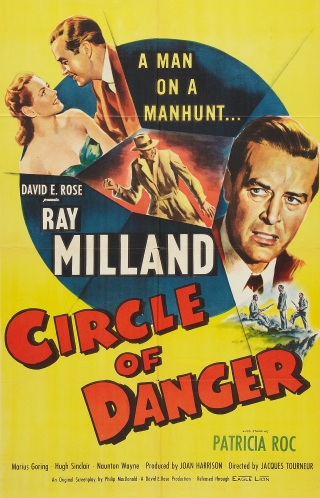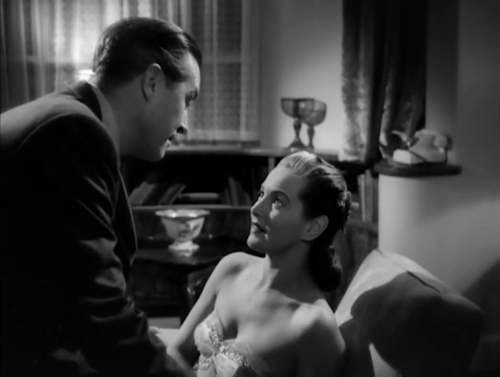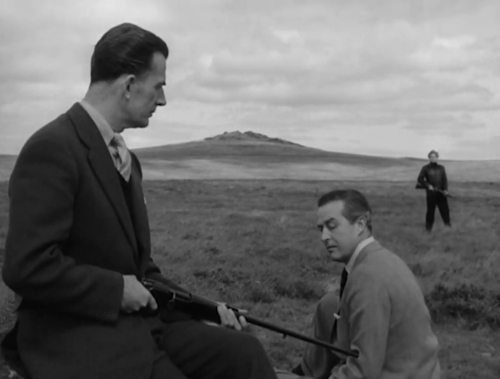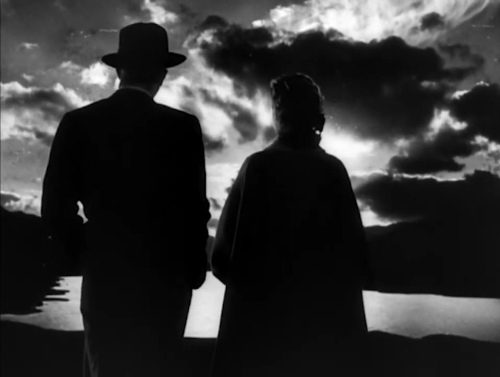Trails followed by hunters have a nasty habit of going cold very fast, but how long does it take a dish to get correspondingly cold? After all, there is that popular tip about the ideal temperature for serving up revenge. One would have thought five or six years ought to do the trick, and that’s about the time Ray Milland’s character takes to get round to seeking out the man responsible for the death of his brother towards the end of WWII in Circle of Danger (1951). Yet revenge is such a corrosive business, rarely bringing any kind of satisfaction to those who most desire it, and then there’s always that thorny question of whether or not it’s actually justified.
It’s perhaps a little unexpected to see a movie mainly shot in and featuring a cast and crew drawn largely from the UK opening on a salvage vessel operating off the Florida coast. Well that’s where we first come across Clay Douglas (Ray Milland) as he and his partner have just struck gold, or maybe I should say tungsten. This is the opportunity Douglas has been waiting for, five years of hard work finally paying off and allowing him to trade in his share in the business for thirty thousand dollars. He’s not looking to retire or anything, instead he’s been working to earn enough money to fund a trip to the UK in search of the truth about the demise of his younger brother. Despite his seemingly easy manner, Douglas is something of a driven man, fully focused on finding out how the kid brother he had almost single-handedly brought up came to die on a commando raid. People die all the time during major conflicts, even those plying trades nowhere near as perilous as that of a commando. So why would a man travel half way round the world to dig into this particular event? The fact is that the fog of war seems to lie especially thick around it all, and there was a rumor that the younger Douglas was dispatched by one of his own comrades in arms. The hunt for the truth has Clay Douglas cannoning round all the points of the compass, from London to the valleys of Wales and on to the Highlands of Scotland. Both the war and the subsequent passage of time has whittled the list of men who might be able to furnish him with the information he craves down to a mere handful. And it remains to be seen whether the tale that emerges is the one he had hoped to hear at the outset.
Straightforward revenge stories are never all that interesting. Sure there’s a certain visceral thrill to be tapped into if the elements are lined up in the right way, but such yarns tend to take on an exploitative feel which I generally find unappealing. The better examples, and I think Circle of Danger qualifies as such, raise questions that ought to make both the protagonist on the screen and the audience facing it a trifle uncomfortable. It all boils down to whether or not life’s thorny tangles can be adequately addressed in cut and dried, binary terms. I don’t think it’s giving too much away here to say that Philip MacDonald’s script turns the central quest back upon itself by the end, forcing not only the avenger to question himself, but also requiring the viewer to reassess a number of preconceptions we’ve been hitherto encouraged to blindly accept. This renders that three cornered confrontation on the Scottish moor all the more fascinating, and consequently leads to a resolution which is enriched by its acknowledgment of the sometimes ambiguous nature of justice. A delicate subject of this kind needs to be handled sensitively, not with a heavy lump hammer approach, so producers Joan Harrison and David E Rose deserve credit for securing the services of a director with the lightness of touch and subtlety of Jacques Tourneur.
There has to be something steely and almost obsessive about a man who is prepared to hand over a significant chunk of his life in the pursuit of retribution. I wouldn’t want to claim it is a state of mind exclusive to the years following the Second World War but, in cinematic terms at least, it is a motif that was explored recurrently and came to characterize more than a few screen protagonists – James Stewart was a prime example of this phenomenon but he was certainly not the only one. This needs a quality of intensity to carry it off, something Ray Milland touches on throughout Circle of Danger, particularly in the climactic scenes in the Highlands, but probably not as consistently as he might have. That’s not to say his character is ever less than focused on the ultimate prize, but he does drift towards casualness bordering on nonchalance on occasion, not least when he’s flirting with Patricia Roc. She brings a freshness and vitality to the movie, a teasing allure that still allows her to switch to a more serious mode when she senses betrayal of one form or another. The other person vying for her attention is Hugh Sinclair’s reticent Scot, the one-time leader of the commando group and a man who seems none too keen on furnishing any more details on past than he can help. His is a key role and Sinclair does well in getting across both the caution of the man as well as what I can only term contained suffering. Then there is Marius Goring giving an energetic yet wholly credible performance as the man whose homosexuality is never openly stated (it is a 1951 movie after all) but which is very clearly alluded to. I think one of the most interesting aspects of the script in general is way it encourages the audience to make various initial assumptions about all three of the male characters before challenging these preconceptions and upending them.
Circle of Danger had been released on DVD by the now defunct Network in what was an entirely acceptable edition. However, it has recently reappeared on Blu-ray via Studio Canal – I haven’t seen that transfer yet but I would expect it to enhance the visuals, and there are some fine looking shots in the film courtesy of cinematographer Oswald Morris. This is a good movie, deftly directed by Jacques Tourneur and cleverly written by Philip MacDonald, drawing the viewer in, setting up certain expectations and then neatly subverting them in a way that continually poses questions which tend to defy pat or convenient answers. It’s a film I’m happy to recommend.




I’ll second your recommendation for this one.
LikeLike
Tourneur’s direction has his characteristic deftness and I very much like the way the story takes us to a rather different place to that which is suggested at the beginning.
LikeLiked by 1 person
Tourneur did a lot of movies in the 50s that don’t get a huge amount of attention despite being really interesting. Movies like The Fearmakers, which tends to divide people quite a bit.
LikeLike
Most of Tourneur’s films are admired on some basis after the fact, but interms of success do not quite make it.
LikeLike
There are none that I’ve seen which I haven’t liked. All of those I’ve caught up with have succeeded on some level at least, and on multiple levels in a good many cases.
LikeLike
That they succeeded personally is not a reasonable reference point. We al like things some of which do not return their investment or justify it.
LikeLike
Well clearly. One of the reasons this place exists, it’s own reference point if you like, although not the only one, is to highlight the movies which I think have value. I try to maintain a degree of objectivity too of course, but as with anyone offering an appraisal I must naturally give my personal impression.
LikeLiked by 1 person
Makes sense.
LikeLike
I have a copy of that to hand and hope to get to it some time soon.
LikeLike
I’d be really interested to hear your thoughts on it.
LikeLike
I’ve enjoyed most of Tourneur’s 1950s movies that I’ve seen. I liked Nightfall a great deal. I even liked Timbuktu. Lightweight adventure romance but perhaps with just a bit more to it than you might expect. There’s even a hint of a redemption theme.
LikeLike
I haven’t seen the latter yet as none of the available copies seem to look great, which has put me off to an extent.
LikeLike
I need to check out more Tourneur’s work. I love ‘Out of the Past’ and ‘Canyon Passage’, of course. Need to watch my DVD copy of ‘I Walked with a Zombie’ again by him.
LikeLike
All of his three films for Lewton are excellent in my opinion.
LikeLike
Don’t forget Night of the Demon. Another excellent Jacques Tourneur-directed horror film.
LikeLike
I’ll second that. It displays a subtle creepiness that recalls those earlier movies made for Lewton’s RKO unit.
LikeLiked by 1 person
This is one I don’t recall seeing, but your review makes me want to seek it out. Generally I like most of Milland’s films.
LikeLike
If you enjoy Milland’s work, I think you’ll find the movie worthwhile. He gives good value and has some strong support from the other cast members.
LikeLike
Have you seen ‘Panic in Year Zero’ directed and starring Milland? Thought it was a fascinating, decent film. I need to check out his Western too.
LikeLike
Yes, I have seen that one, but not for a fair few years now. It’s a good piece of budget filmmaking.
A Man Alone is well worth your time too.
LikeLike
Ray Milland was just so good in Dial M for Murder. And in The Premature Burial – he was certainly versatile.
I quite enjoyed Lisbon, which he directed. A low-key thriller but fine entertainment.
LikeLiked by 1 person
Yes, a minor film all told, but an entertaining one.
LikeLike
I know its ‘Love Story’ but Milland is good in it. Solid. Now the most insane thing he was in is the two headed movie with Rosie Grier. That is some crazy stuff.
LikeLike
Patricia Roc really is a forgotten actress. She did some very interesting slightly offbeat movies is both lead and supporting roles – The House in the Woods, The Hypnotist, The Man on the Eiffel Tower, The Wicked Lady and the amazing Madonna of the Seven Moons. If an interesting movie was being made in Britain at that time she always seemed to be in it.
LikeLike
She did indeed appear in a number of movies that are worth seeing – I’m rather fond of those Gainsborough Pictures titles myself.
And of course she had a part in Tourneur’s earlier Canyon Passage.
LikeLiked by 1 person
It’s been years since I saw this along with A Man Alone, I remember liking the mix of romance and touch of comedy, but it’s still just bleak enough (plus stylistically like Curse of the Demon) and definitely absorbing. Wouldn’t mind a revisit
LikeLiked by 1 person
Worth a revisit, I’d say. Yes, it does get the blend right, which isn’t always the case with some movies.
LikeLike
Good film. I love Ray Milland and Marius Goring(one of the greatest character actors). So sad how little known Patricia Roc appears to be now. She was one of our biggest stars here in the UK during the classic era. I love her in Millions Like Us, The Wicked Lady, When The Bough Breaks and Love Story.
LikeLike
Re Roc: I think the fact she retired from acting quite early at least partially explains why she is not better remembered.
LikeLike